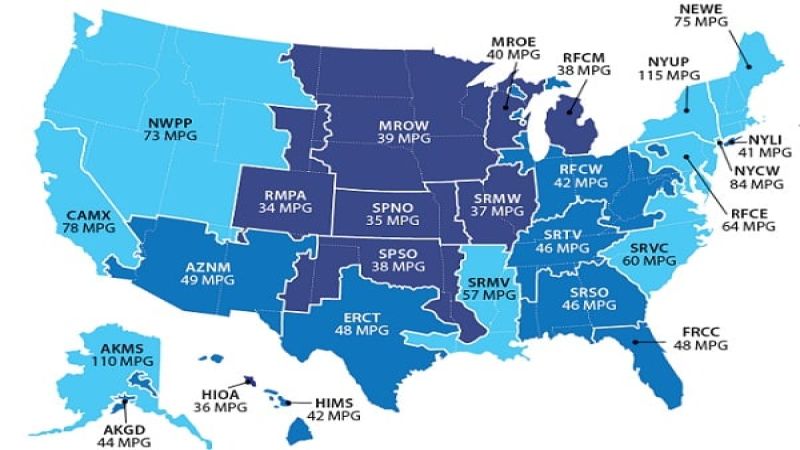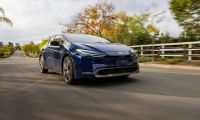A recent 30 Seconds to Know NBC News segment implied that electric vehicles are “not really” cleaner than gasoline cars. Aside from the obvious fact that 30 seconds isn’t nearly enough to tell the full story, the “expert” spouting such unsupported claims can be disproved soundly with some research, reasonable assumptions, and a calculator.
According to the EPA, every kWh produced from coal yields 2.25 pounds of CO2 while natural gas power plants emit 1.14 pounds per kWh. The national average electricity mix in 2013 according to the Energy Information Administration was as follows: 39% coal, 27.5% natural gas, 19.5% nuclear, and 13% renewables and hydroelectric power. The remaining 1% fell under the category of biomass and “other” fossil fuel sources.
This means the average kWh in the United States emits approximately 1.2 pounds of carbon dioxide. Accounting for transmission losses and “feedstock,” for example the emissions associated with the mining and transport of coal, increases the number to about 1.35 pounds of CO2 per kWh.
A typical gallon of gasoline releases 19.6 pounds of CO2 when burned. That gasoline first must be drilled as oil, refined, and transported, which according to the EPA requires multiplication by a factor of 1.25 to yield 24.5 pounds of CO2 per gallon.
To make our comparisons we will assume the national average grid electricity mix, although this clearly will vary by region. Even within a given region the contents of the electricity cocktail will fluctuate over the course of a day. The Union of Concerned Scientists offers an excellent report on EV fuel costs and emissions along with a helpful graphic on equivalent MPG for electric vehicles, based on greenhouse gas emissions, in various regions across the United States that you can find here.
First we will compare the most popular EV, the Nissan LEAF, with one of the most popular gasoline compact cars, the Toyota Corolla. Assume 31 MPG combined for the Corolla and a reasonably achievable 265 Wh/mile for the LEAF, or 3.77 kWh/mile. Driving 12,000 miles per year, the Corolla will emit (12,000/31)*24.5 = 9,484 pounds of CO2 annually. The LEAF, on the other hand, will produce (12,000/3.77)*1.35 = 4,297 pounds of CO2. This is a 56% reduction of CO2 emissions.
To give the legacy vehicles a fair chance, next we will compare the Tesla Model S with a BMW 528i, which achieves an EPA-rated 27 MPG combined. Assume 15,000 miles driven per year this time and an efficiency of 350 Wh/mile for the Tesla, or 2.86 miles/kWh based on a rough average of real world owner data. The BMW would produce (15,000/27)*24.5 = 13,611 pounds of CO2 annually. The Tesla Model S would emit (15,000/2.86)*1.35 = 7,080 pounds. This represents a 48% reduction in CO2 emissions for the EV.
Okay, let’s play devil’s advocate. What happens if you own an EV in West Virginia and, hypothetically of course, your electricity comes from 100% coal? In that case, the LEAF emits 8,244 pounds of CO2 over 12,000 miles and Model S emits 13,571 pounds over 15,000 miles. Still reductions over the legacy vehicles, of 13% and 0.3% respectively.
A legitimate knock on electric vehicles is the pollution caused by their battery and motor manufacturing, as rare earth metals are environmentally unfriendly to extract and the production of batteries is energy-intensive. However, Tesla has said that an internal study indicates the immense efficiency gains of Model S offset any added battery-related emissions within just 10,000 miles of driving despite the size of the industry’s largest battery pack by far.
It is difficult to judge the impact of rare earth extraction, but battery production itself isn’t as serious of a concern as skeptics might claim. In addition, once Tesla’s Gigafactory is up and running their batteries will be made with energy largely coming from nearby wind and solar generation, and the environmentally conscious company will have great control over start-to-finish waste and emissions of battery production.
All of this, however, doesn’t even bring up the larger “point” of electric vehicles. Yes, they are currently friendlier to the atmosphere than gasoline cars. But the future of electric vehicles holds so much potential; their batteries new and used will be vital to the smart grid and stabilizing wind and solar power, and their road miles become cleaner as the electricity grid evolves and integrates more renewable energy sources.
In the year 2000, coal represented 52% of U.S. electricity generation. Its share has fallen to just 39% in the last 14 years and shows no signs of increasing. More and more people are going carbon-free by plugging their EVs into electricity generated by residential solar power. Sure, China has been building new coal plants like there’s no tomorrow, but that does not mean we should neglect our responsibility to clean up our own act. Barring an unexpected fuel cell revolution, achieving low or zero-carbon transportation absolutely cannot be done without plug-in electric vehicles.
From a CO2 standpoint electric vehicles will always come out on top by a wide margin, and that margin will only increase with improvements to our electricity supply. It is time news outlets and the public at large accept that fact.













Comments
I love stories with math
Permalink
I love stories with math (seriously) but why pick the Corolla? At a glance it would seem that a Prius burning only gasoline (not a PIP), with a 50 MPG rating, comes a lot closer to the Leaf. There is no closer competitor to the Leaf than the Prius. Both are clean, green cars of the same size. The Corolla is impressive. The LE Eco version gets 35 MPG, but it is just a regular gasoline car, not one focused on environmental impact and top fuel economy. Toyota has promised a 5% fuel efficiency increase in the next gen. The truth is that in affordable passenger cars, the best gasoline only powered vehicles are not really much different than the EVs. Until coal and gas are replaced this will not really change.
John, I picked the Corolla
Permalink
In reply to I love stories with math by John Goreham
John, I picked the Corolla because it is more representative of the gas-burning vehicle fleet as a whole than the Prius. It is a moderately frugal compact car without hybridization technology, fairly fuel-efficient within its fuel-efficient class. Sure a Prius is closer to an EV in terms of emissions, but it is also the most efficient gasoline vehicle on the market and most vehicles (especially non-hybrids) lag pretty far behind. So in comparing electrics to typical gasoline vehicles, it wouldn't be fair to pick the best gasoline vehicle.
Yes, that makes good sense.
Permalink
In reply to John, I picked the Corolla by Luke Ottaway
Yes, that makes good sense. It represents the non-hybrid cars well. Great story. BTW, I backed out the 19.6 pounds of carbon dioxide per gallon number starting with the 197 grams/mile the Prius outputs. Came out spot-on.
"In the year 2000, coal
Permalink
"In the year 2000, coal represented 52% of U.S. electricity generation. Its share has fallen to just 39% in the last 14 years and shows no signs of increasing."
Do you really want to get into the politics of WHY this is happening? It could be steady or increasing if the political climate would allow it. That's the OTHER side of this equation - we have coal available now. And when you look at the pie chart of how much of our power is generated by various sources - solar, wind, and geothermal combined make up less than 1% - because they're just not efficient enough right now.
Doesn't mean that they won't be - and if we could get solar panels on the roofs of the EV's so they could also trickle charge the batteries during the daytime, that would also help with urban commuter EV's. They're still not going to work out here in flyover country or for hauling large quantities of freight and materials.
I don't understand why people
Permalink
In reply to "In the year 2000, coal by Carl (not verified)
I don't understand why people make clearly fact check ke statements without fact checking themselves first. For 2013 wind produced 167.67 gWh, solar 8.32 gWh and geothermal 16.52 gWh for a total of 192.51 gWh total US generation in 2013 was 4058.21 gWh meaning wind, solar and geothermal made up 4.74% of total generation NOT "less than 1%". Furthermore the EIA data does NOT even include rooftop solar generation, only utility scale solar generation, which represents well under 50% of all solar generation so the solar number is actually significantly higher then represented here. Please don't make up facts to suit your opinions.
None of these alternative
Permalink
In reply to "In the year 2000, coal by Carl (not verified)
None of these alternative forms of energy will ever be practical for large scale energy production. There are so many limitation on their production and they lack the ability for 24/7 instant response to energy demand. The alternative energy field will always be a niche field available only to a small portion of the worlds consumers. They like electric cars are now and forever will be niche items available to only small portions fo the US consumer.
If the world wants a completely clean energy with long term availability and 24/7 energy on demand then more research should be done to develop an atomic converter system that will make it possible to convert the radiation produce directly into electrical power without the use of fission to produce hear to turn water into steam to power turbines. This way the current radioactive spent fuel rods that are now being store can instead still be used to produce electrical power hundreds of years into the future.
"ncrdbl1" please provide a
Permalink
In reply to None of these alternative by ncrdbl1 (not verified)
"ncrdbl1" please provide a link that shows that somebody is working on developing the equipment that is used to convert Radiation directly to electricity. What type of radiation do you want this equipment to run on? Gamma, Alpha, neutrino, Beta?
Wind power if located properly can produce electricity 24/7. same with hydro, biomass and geothermal. Or they can produce electricity when the solar is not available. Since the demand for electricity is highest during the daylight hours and during the summer months solar CAN make a meaning full impact on the electric mix in this country. Please note that the USA uses a mix of energy sources to generate its electricity. increasing solar generated electricity during the daylight hours will reduce fossil fuel consumption during this time period.
Pollution controls are making
Permalink
Pollution controls are making coal more expensive to burn to produce electricity. Falling natural gas prices are making that cleaner burning fuel more popular with electric power generators. I also might question the accuracy of the 1% claim for renewables. We have solar pv and our electric generation is NOT reported to anybody. Our electric company can only monitor our excess production and not our total production.
It's worth pointing out the
Permalink
It's worth pointing out the the "rare earth materials" mentioned in the original NBC video and repeated here is really a non-issue. Tesla's and BMW's electric motor is an induction motor that uses zero rare earths, as our several other manufacturers' motors. Ironically the hybrid Prius motors are the biggest consumers rarer earths in the automotive world, but the are consumed in even greater quantity in the magnets used in everything from audio speakers to CRT video displays. As electric cars scale up, all major manufacturers will switch to induction motors and the whole rare earth accusation will be a total non-issue (or myth, as it already is)